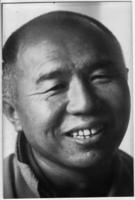
The way up to the new monastery site was arduous, so it was best to attempt it in the early morning. We climbed the hill as the mist was clearing from the valley. As we rose higher, the busyness and distraction of Katmandu City lessened. We would catch our breath every several hundred meters but today we seemed to glide up effortlessly. We anticipated that Tulku Urgyen Rinpoche would grant our request and that he would tell his many memoirs in an orderly fashion.
Graham Sunstein and I arrived at the building site that would one day be the Ngedon Osel Ling monastery. The mud, bustle and movement of workers amidst heaps of building supplies lined the landscape. We climbed the stairs and waited outside Rinpoche’s room. Although it was early, we knew that he had been awake and active for hours. The shoes outside his door attested to this. As we peeked through the curtain, we had our first glimpse that day of Rinpoche. He motioned us in.
Tulku Urgyen Rinpoche always established a very cozy environment, no matter where he was. It was as if sunlight and warmth permeated every place he stayed. An almost transparent atmosphere of light showered down. It made the contrast to the very real and solid work going on forgotten. Tulku Urgyen Rinpoche was not a large man, yet he was all embracing and present. Merely coming before him transformed your ordinary perceptions, even though he was so humble and self-effacing. It was as if he was trying to hide all his qualities, yet even he was unable to do so.
He was blazing splendor, the look, the compassion, and the realization. When he spoke we were enraptured, captivated by the combination of brilliance, humor and sheer raw awareness. A few others were present within the room. Our attention moved to Rinpoche’s youngest son, also an incarnate Lama. He smiled warmly, his open friendliness held our gaze. He had just completed a three-year retreat and at seventeen was developing into a very good copy of his father. He was accompanyed by his attendant, an Eastern Tibetan lama. Lastly inside, there was Rinpoche’s sister, Sagala, so simple, so sweet.
After we prostrated we once more made our request: Rinpoche, please tell us your life story and what it was like in Eastern Tibet and Lhasa. The others in the room waited, it was definitely a captive audience. There was an air of excitement as we waited to see if he would comply. The tape recorder was on, the mike set as we stared at his radiant dignity.
I was born in Tibet, taken to Kham, then went back and forth between the two several times. I fled the communists to Sikkim and finally moved to Nepal, where I am now living as an old man. That’s my life in a nutshell. I haven’t accomplished any great deeds. Mostly it’s just one sad event after another.
I belive this was in 1994, and this interview became the first of many, perhaps to fill forty tapes. Earlier on, in 1983, Andreas Kretschmar and I had recorded maybe ten tapes based on the traditional chant to the masters through whom Tulku Urgyen had received his teachings (http://www.rangjung.com/gl/tersar-supplication.htm) while Rinpoche was recovering in the hospital in Cologne.
1 comment:
After reflecting upon what Tulku Urgyen Rinpoche placed the highest emphasis on it became clear to us it was a landscape of people, rather than physical places. It then became obvious to use those people who inspired him most as the main structure for this book. Rinpoche gave very little importance to actual dates and only mentioned them when pressed. Still we used the sequence of his life as the backbone to string together these wonderful stories. Each story is a jewel of timeless value strung together by Rinpoche’s memory, we present here as a beautiful necklace for you to enjoy.
Post a Comment